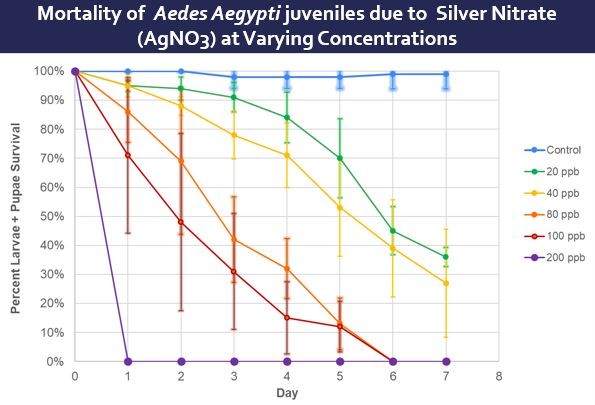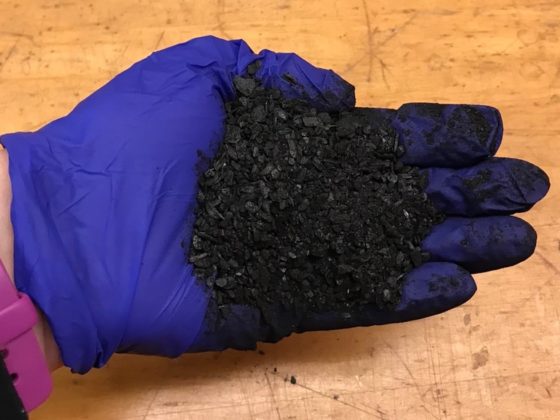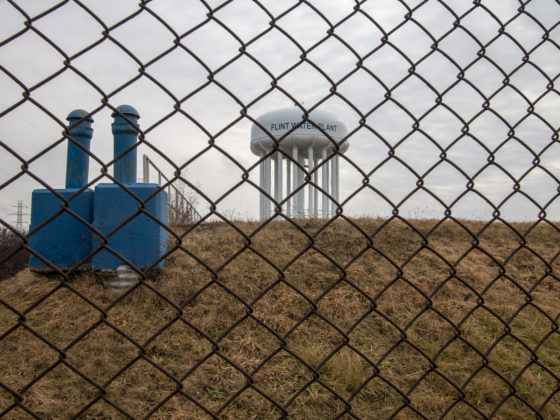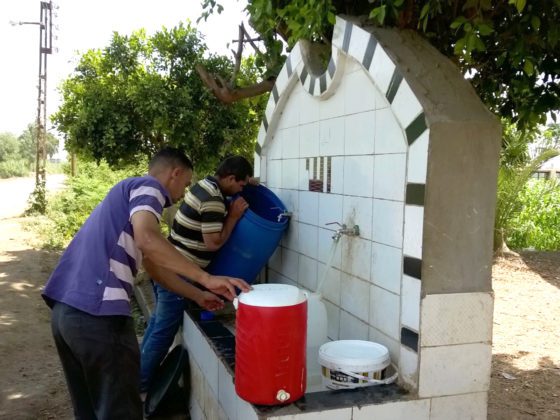In spite of the coronavirus pandemic, the Global Water Initiative organized the third edition of the annual Graduate Water Symposium. Nine students from across UVA presented their water-related research at the virtual symposium. Sydney Turner, from the Department of Engineering Systems and Environment (ESE) in the School of Engineering, won this year’s top prize with a presentation on Evaluation of Water Treatment Disinfectants for Larvicidal Effects on Aedes Aegypti. Honorable mentions went to Ben Bowes (also from ESE), who works on Flood Mitigation in Coastal Urban Communities using Real-time Stormwater Infrastructure Control and Reinforcement Learning, and Sarah Hogan (from Environmental Science), who works on Quantifying the Dual Benefits of Oyster Restoration. We talked with this year’s winner, Sydney Turner.
You study mosquitoes and water treatment. How are the two related?
Many areas lack centralized water treatment and distribution systems that can bring treated water directly into a home. Without such a system, individual households have to devise ways to collect, store, and treat their own water. Prof. James Smith’s research group has been studying and developing “point-of-use” treatment methods to create cost-effective means for households to safely store and treat their own drinking water. These point-of-use drinking water treatment methods—which include ceramic filters; Madi-drop tablets; and disinfectants silver, copper, and chlorine—have focused on eliminating bacterial and viral pathogens with health impacts such as diarrhea and growth stunting. However, storing water in open containers creates a habitat for larval mosquitoes, and in fact becomes the mosquito habitat closest to the household. After the larvae emerge from the water in the containers, the adult mosquitoes, such as Aedes aegypti, can carry and spread dengue virus, yellow fever virus, chikungunya virus, and Zika virus to humans. Based on data collected over the years on vector-borne diseases, mosquito-borne infectious diseases make up the highest number of reported cases, mortality, and disability-adjusted life years.[i] Despite the ongoing fight against malaria, hundreds of millions of cases of malaria occur each year, killing about 400,000 people annually.[ii] An estimated 100 million to 400 million dengue infections occur each year, with the global incidence growing dramatically in the recent decades.[iii] My research leveraged the drinking water treatment expertise of the Smith group. We realized that we might have the opportunity to address another water-related public health issue if we could safely treat the stored water to stop the mosquitoes from becoming adults and spreading disease. It was essential to use very low concentrations of chemicals to meet health standards.
How did you become interested in this type of research?
I was not one of those people who went into engineering because I was a math whiz. I chose to study engineering because of its problem-solving focus: it teaches you how to solve hard problems using math and science. I was especially interested in helping people and communities. And I feel that my research is just one degree away from having an impact. I thrive on that real tight connection to real people. This research brings that all together; it is problem-solving, and it allows me to work directly with the communities to help them to be able to protect their health.
Can you lay out some of the experiments that you have been running in your lab and some of the challenges you found?
In my lab work, I simulate a water storage container. I purchase the eggs of Aedes aegypti, which come attached to paper strips. I then add the mosquito eggs to beakers to perform bioassay experiments. This essentially means I am focused on measuring the potency of a substance, specifically a water disinfectant, by its effect on the mosquito juveniles. I measure, under various conditions, how well the eggs or different instar larvae develop to the stage of emergence, which is when the adults can leave the water. We don’t keep a mosquito colony, so at the end of each experiment all the mosquitoes, regardless of what stage they are in, are destroyed. I have been studying different concentrations of silver and chlorine in the bioassays and have plans to move on to testing copper next. I have found that silver and chlorine both negatively impact mosquito development, but possibly in different ways, so we may also look at using both concurrently. Before I could even begin testing the treatments, though, one of my biggest challenges was learning how to make the mosquitoes “happy”; that is, how to create conditions that would encourage at least 70% of them to develop to emergence. After months of adjusting the environmental conditions I provided the mosquitoes and talking with experts on raising mosquitoes, I finally got the mosquitoes to grow and I could actually begin my experiments.

 Do you see any particular challenges to implementing your findings?
Do you see any particular challenges to implementing your findings?
The challenges are similar to any case where one tries to insert an intervention, such as point-of-use treatment, into a community. Currently I am using treatments based on concentrations of chemicals in the water. There can be multiple approaches to adding these chemicals to the water. My initial research is intentionally separated from the specific treatment intervention used in the community. To actually implement an intervention, one has to work closely with the community, understand their knowledge base related to public health drivers, and learn the water treatment options that are workable and familiar for them.
Any advice for current or future graduate students?
I think one of the important lessons of being a graduate student is to give yourself the space to develop. No one starts as an expert, but through running your experiments, talking with experts, and reading the literature, you will see that over time that you are becoming that expert. With this in mind, I hope you have the confidence to learn new things—like maybe hatching mosquitoes.
_________________________
[i] World Health Organization, “Annex 1. Global Burden of Major Vector-Borne Diseases, as of March 2017,” Global Vector Control Response 2017–2030 (2018), http://www.who.int/vector-control/burden_vector-borne_diseases.pdf (accessed Dec. 3, 2020).
[ii] “In 2018, an estimated 228 million cases of malaria occurred worldwide…[and] there were an estimated 405 000 deaths from malaria globally” (World Health Organization, “The ‘World Malaria Report 2019’ at a Glance,” December 4, 2019, https://www.who.int/news-room/feature-stories/detail/world-malaria-report-2019 [accessed Dec. 3, 2020]).
[iii] World Health Organization, “Dengue and Severe Dengue: Key Facts,” June 23, 2020, https://www.who.int/news-room/fact-sheets/detail/dengue-and-severe-dengue (accessed Dec. 3, 2020).





